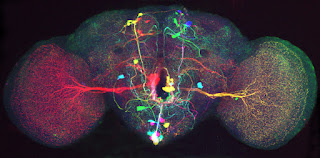Professor Vesna discussed the evolution of X-Rays and MRIs and how that came about to save a lot of lives concerning medical cases of cancer, seizures, strokes, etc. Personally, I have seen the wonders of these machines as they have helped my father detect he had cancer and show my mother's degenerative arthritis eating her knee.
 |
| MRI Machine |
I find it very odd that machines of such kind in its infancy was considered art and not of use for medical practices. They have clearly been of great use in discovering and exploring different diseases and medical anomalies, and I am forever grateful of the impact it has had on my family.
These new technologies have also been educational to the general public, specifically with the evolution of plastication in which polymers and body tissue are morphed to construct a body art form. This art created by Gunther Von Hagens was originally intended for medical instruction but later became public as an exhibit, showing preserved human bodies to educate the general population. I have personally been to this exhibit many times and it is quite fascinating.
There are also the down sides to medical technologies, for me specifically in cloning and mutation. I will take two movies to go off:
The Island and
X-Men.
 |
| Clones |
In
The Island, there is a group of clones that are held in a reservation and believe the real world is too contaminated with the exception of the island that isn't contaminated. Essentially people that are raffled off to the island are murdered as they are utilized for medical purposed for their real-life counterparts. X-Men deals with mutants, or the people that have special abilities due to their mutated DNA. There is a big ordeal of trying to overthrow the mutants as well as perform research on them for bad purposes. Both of these movies, though clearly fictional, offer a scary future that may come into reality if technology goes into the wrong hands. Many ethical dilemmas can be brought up if technology is used in such a neglecting manner.
Despite these outlooks, medical procedures find itself submerged into the artistic world, as shown by Orlan. She is famous for having reconstructive surgeries as a way to express different art eras and genres. Though I wouldn't personally go through this ordeal, like many reporters say in the documentary, it is a unique art form that combines medical advances and art.
 |
| Christophe Luxereau picture of Robotic Knee Implementation |
Resources:
Beatowner. "The Island Trailer."
YouTube. YouTube, 29 Sept. 2007. Web. 24 Apr. 2016.
MutleeIsTheAntiGod. "Orlan - Carnal Art (2001) Documentary." YouTube. YouTube, 13 Mar. 2011. Web. 24 Apr. 2016.
Petersenjak. "X Men (2000) - Trailer 1 HD."
YouTube. YouTube, 04 Aug. 2009. Web. 24 Apr. 2016.
Uconlineprogram. "Medicine Pt2." YouTube. YouTube, 21 Apr. 2012. Web. 24 Apr. 2016.
Von Hagens, Gunther. "Bodyworlds."
Bodyworlds. Institute for Plastication, 2006. Web. 24 Apr. 2016.



































